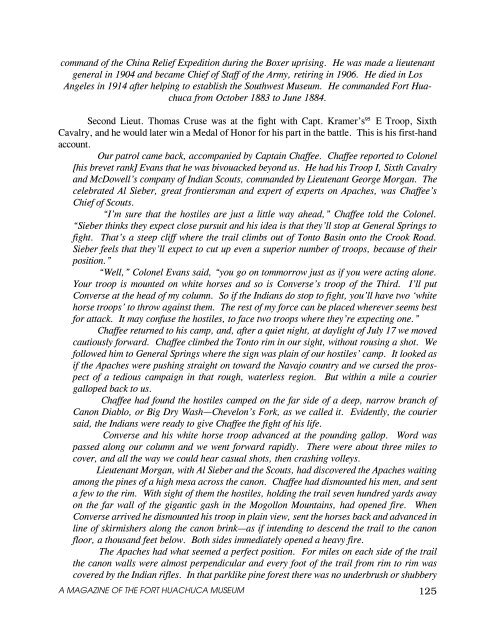Apache Campaigns - Fort Huachuca - U.S. Army
Apache Campaigns - Fort Huachuca - U.S. Army
Apache Campaigns - Fort Huachuca - U.S. Army
Create successful ePaper yourself
Turn your PDF publications into a flip-book with our unique Google optimized e-Paper software.
command of the China Relief Expedition during the Boxer uprising. He was made a lieutenant<br />
general in 1904 and became Chief of Staff of the <strong>Army</strong>, retiring in 1906. He died in Los<br />
Angeles in 1914 after helping to establish the Southwest Museum. He commanded <strong>Fort</strong> <strong>Huachuca</strong><br />
from October 1883 to June 1884.<br />
Second Lieut. Thomas Cruse was at the fight with Capt. Kramer’s 95 E Troop, Sixth<br />
Cavalry, and he would later win a Medal of Honor for his part in the battle. This is his first-hand<br />
account.<br />
Our patrol came back, accompanied by Captain Chaffee. Chaffee reported to Colonel<br />
[his brevet rank] Evans that he was bivouacked beyond us. He had his Troop I, Sixth Cavalry<br />
and McDowell’s company of Indian Scouts, commanded by Lieutenant George Morgan. The<br />
celebrated Al Sieber, great frontiersman and expert of experts on <strong>Apache</strong>s, was Chaffee’s<br />
Chief of Scouts.<br />
“I’m sure that the hostiles are just a little way ahead,” Chaffee told the Colonel.<br />
“Sieber thinks they expect close pursuit and his idea is that they’ll stop at General Springs to<br />
fight. That’s a steep cliff where the trail climbs out of Tonto Basin onto the Crook Road.<br />
Sieber feels that they’ll expect to cut up even a superior number of troops, because of their<br />
position.”<br />
“Well,” Colonel Evans said, “you go on tommorrow just as if you were acting alone.<br />
Your troop is mounted on white horses and so is Converse’s troop of the Third. I’ll put<br />
Converse at the head of my column. So if the Indians do stop to fight, you’ll have two ‘white<br />
horse troops’ to throw against them. The rest of my force can be placed wherever seems best<br />
for attack. It may confuse the hostiles, to face two troops where they’re expecting one.”<br />
Chaffee returned to his camp, and, after a quiet night, at daylight of July 17 we moved<br />
cautiously forward. Chaffee climbed the Tonto rim in our sight, without rousing a shot. We<br />
followed him to General Springs where the sign was plain of our hostiles’ camp. It looked as<br />
if the <strong>Apache</strong>s were pushing straight on toward the Navajo country and we cursed the prospect<br />
of a tedious campaign in that rough, waterless region. But within a mile a courier<br />
galloped back to us.<br />
Chaffee had found the hostiles camped on the far side of a deep, narrow branch of<br />
Canon Diablo, or Big Dry Wash—Chevelon’s Fork, as we called it. Evidently, the courier<br />
said, the Indians were ready to give Chaffee the fight of his life.<br />
Converse and his white horse troop advanced at the pounding gallop. Word was<br />
passed along our column and we went forward rapidly. There were about three miles to<br />
cover, and all the way we could hear casual shots, then crashing volleys.<br />
Lieutenant Morgan, with Al Sieber and the Scouts, had discovered the <strong>Apache</strong>s waiting<br />
among the pines of a high mesa across the canon. Chaffee had dismounted his men, and sent<br />
a few to the rim. With sight of them the hostiles, holding the trail seven hundred yards away<br />
on the far wall of the gigantic gash in the Mogollon Mountains, had opened fire. When<br />
Converse arrived he dismounted his troop in plain view, sent the horses back and advanced in<br />
line of skirmishers along the canon brink—as if intending to descend the trail to the canon<br />
floor, a thousand feet below. Both sides immediately opened a heavy fire.<br />
The <strong>Apache</strong>s had what seemed a perfect position. For miles on each side of the trail<br />
the canon walls were almost perpendicular and every foot of the trail from rim to rim was<br />
covered by the Indian rifles. In that parklike pine forest there was no underbrush or shubbery<br />
A MAGAZINE OF THE FORT HUACHUCA MUSEUM<br />
125

















